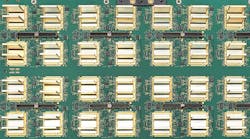UPDATE: Multi-Function Phased-Array Radar System Completes Field Trials
Update: Following the successful field trial of the MPAR system, MACOM received the first production order for its Scalable Planar Array (SPAR) tiles from the MIT Lincoln Laboratory. According to a statement from the company, the Lincoln Laboratory plans to incorporate these tiles—the RF assemblies that form the basis of an MPAR antenna—into the first full-scale MPAR system.
SPAR tiles serve as the building blocks of the MPAR planar active electronically scanned antenna (AESA). The tiles contain the antenna elements; gallium-arsenide (GaA) and gallium-nitride (GaN) components; transmit and receive modules; and RF power distribution networks for the radar system. The tiles are designed to be combined with additional signal generation and receive and control electronics to complete the MPAR antenna.
MACOM has also announced that the Lincoln Laboratory plans to incorporate SPAR technology into a test bed for the Defense Advanced Research Project Agency’s (DARPA) Arrays at Commercial Timescale (ACT) program. The program is focused on incorporating commercial technology into a new generation of radar, electronic warfare (EW), and communications systems. Specifically, the agency is adopting practices from the commercial domain to streamline development and manufacturing cycles in the military sector.
Previously: The widespread use of phased-array radars in military applications is gradually filtering into the civil and commercial sectors. The first Multifunction Phased-Array Radar (MPAR) system, for instance, completed a successful field test with the National Severe Storms Laboratory in Oklahoma. Developed by the MIT Lincoln Laboratory and MACOM Technology Solutions Inc., the MPAR-based system integrates eight legacy radar functions into a single platform for simultaneous weather surveillance and air traffic control.
The dual-polarized radar system is designed with multiple MPAR tiles to radiate and receive pulses of radar energy. For the system tested in Oklahoma, these tiles were arranged into four phased-array antenna faces, positioned at different angles for 360-deg. radar coverage. The system is not dependent on any moving parts and electronically shapes its radar beam. The agility of the radar beam permits faster full-volume scan rates and increased resolution, according to Jeff Herd, group leader of RF Technology at the Lincoln Laboratory, in an early article about an MPAR prototype. The phased-array panels function coherently to detect and track aircraft and weather targets.
An MPAR panel is constructed out of 64 antenna elements, each of which has a separate radiator and transmit-receive module that amplifies controls the phase of the radar signal. The modules are designed with two independent transmit channels and two independent receive channels with switchable beam-former paths. “This architecture,” Herd writes, “allows the module to be rapidly reconfigurable to output either a single dual-polarized or two independently steered linearly polarized signals.”
The system was developed under the sponsorship of the Federal Aviation Administration (FAA) and National Oceanic and Atmospheric Administration (NOAA), underlining the system’s dual functions. The system consolidates eight legacy radar functions, including terminal air surveillance, weather radar, and terminal Doppler radar, among others. MPAR-based systems can increase forecast accuracy for severe weather events, such as tornadoes and hurricanes, and facilitate earlier storm warnings. For the FAA, it has the potential to improve awareness of air traffic patterns, increasing safety and flight efficiencies.
The MPAR radar system could also reduce operating costs. Aside from replacing multiple radars with a single multifunction system, the MPAR is constructed using standard materials and manufacturing processes from the commercial wireless industry—courtesy of MACOM’s experience in this field. Dr. Doug Carlson, vice president of strategy at MACOM, notes that the next step is to move into volume commercial manufacturing.
